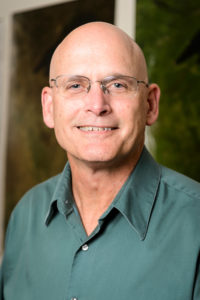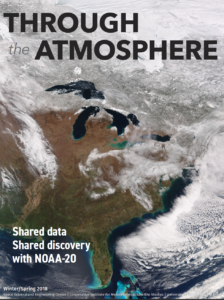Through the Atmosphere Winter/Spring 2018

Credit: Bryce Richter
Director’s Note:
By Steve Ackerman
Interim SSEC Director
Shared data, shared discovery with NOAA-20: The tag line on the cover of this issue of Through the Atmosphere says it all. Our research is grounded in the idea that the global scientific community—and all of society—benefits when research results, and the data that support them, are shared.
All of the stories between the covers of this magazine are linked by their attachment to the principles of shared data. The cover story, for example, highlights the US role, and SSEC’s, in promoting a satellite data policy with no restrictions or encryption. Liam Gumley’s research illustrates the ways NOAA-20 is improving forecasting, how and where his team, and others, are making weather satellite data accessible to anyone, and how they are connecting decision-makers with the data they need, when they need it.
Hurricane Maria left a path of destruction in its wake when it hit Puerto Rico. Fortunately, CIMSS scientist Shane Hubbard had been sharing his knowledge and tools for some time to help communities understand their risks related to natural hazards like hurricanes and ever present flood dangers. His niche research area includes models that not only visualize the effects of these natural disasters, but also helps emergency managers and planners develop mitigation plans.
After learning of her work at an international conference in 2010, the UK Met Office approached CIMSS scientist Eva Borbas about sharing her land surface emissivity global database so that it could be incorporated into the UK’s radiative transfer model. And she did. Her database has provided the UK’s model with more accurate temperature and water vapor retrievals, along with better radiance simulations over clear skies, resulting in an on-going collaboration. Just last year, Borbas oversaw an upgrade to the database, leading to an improved emissivity product.
A little closer to Madison, and to Earth, the UW– Madison Department of Atmospheric and Oceanic Sciences professors Grant Petty, Tristan L’Ecuyer, and Ankur Desai, have partnered with SSEC to purchase, and build, an ultralight, low-altitude aircraft. With instruments onboard, the aircraft will help gather measurements of the lower atmosphere, providing clues to where turbulence might form—sharing their data with researchers across campus.
Another UW–Madison alumnus and pioneer with early connections to SSEC, Terry Kelly was honored last year by the American Meteorological Society for his revolutionary work in computerized weather: work that charted a new course for real-time television weather broadcasting. His goal, like the others featured in this issue, was to get timely weather information to the public and industry, and he has done so quite successfully.
Finally, we include a synopsis of the new biography of SSEC’s founder, Verner Suomi: The Life and Work of the Founder of Satellite Meteorology, which brings us full circle to the visionary who believed so strongly in the value of international cooperation and shared data. Among the SSEC co-authors are Paul Menzel and Jean Phillips who researched with John Lewis of NOAA’s National Severe Storms Laboratory, (formerly at CIMSS during the Suomi era), to present a picture of the man who launched the field of satellite meteorology. I hope you enjoy these stories and more in the Winter/ Spring 2018 issue of Through the Atmosphere.
Read the online issue here: http://www.ssec.wisc.edu/through-the-atmos/

